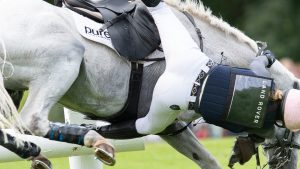A 33% reduction in horse falls has sparked questions, while British Eventing considers additional new safety measures
Eventing risk profiles could help reduce cross-country falls

LRBHT19_CCI5_XC_AUS_ISABEL_ENGLISH_FELDALE_MOUSE-6557 fall falling thrills and spills
RISK profiles could be constructed for combinations competing at international level aimed at reducing the number of cross-country falls, with the help of previous competition data.
In an FEI-commissioned study, FEI eventing: Risk factors for horse falls and unseated riders during the cross-country phase (2008–2018), researchers from the University of Bristol and Nottingham Trent University analysed data from 187,602 horse starts in the cross-country phase of FEI events between January 2008 and December 2018. Of these starts, 2,894 horse falls were recorded and 6,557 unseated riders.
A statistical model was used to identify potential risk factors that could be applied to combinations, based on their individual history and course-level factors. Findings included that combinations competing at two-star and above and over longer courses were at increased odds of a horse fall or unseated rider, compared to those competing at one-star. Mares were found to be at increased odds of a fall compared to geldings and stallions, as were horses with a previous fall at an FEI event compared to horses who had never fallen at an FEI competition. Male riders are at greater odds of having a horse fall compared to females, and combinations who recorded a dressage score of 50 or more were at an increased risk of a horse fall or unseated rider.
Lead author Euan Bennet, who has worked on similar research for the FEI in endurance, told H&H that as the study is multivariable, the results take everything into account.
“The findings show there are things that can be changed and done to reduce the chance of horse falls and unseated riders, such as looking at minimum eligibility requirements [MERs],” he said. “There are things that can’t be changed, such as rider or horse age or sex, but that doesn’t mean that we should just ignore them – it’s when we talk about building a risk profile these things should be taken into consideration.
“This data is about probabilities and we would never say don’t ride because you’re going to have a fall, but we might say what we can see is according to your risk profile you’re in the top 5% at risk of a fall.”
Dr Bennet hopes to meet the FEI eventing committee shortly to review the data and the study’s recommendations.
An FEI spokesman told H&H the study was commissioned as part of its global injury surveillance project aimed at identifying risk factors for horse injuries, particularly those that may have a catastrophic outcome.
“The study reinforces the findings identified by the eventing risk management analysis in risk factors of horse falls in cross-country since 2000. Results from the various studies are used for policy making and technical improvements, allowing the eventing committee to take relevant and informed decisions,” said the spokesman, adding that updates to MERs are being made each year taking into account conclusions of the eventing risk management expert group and the eventing committee based on data collected at all international events for the past 20 years.
Geoff Sinclair of the FEI eventing risk management steering group added that over the period of the study, the number of starts in international eventing increased 50% globally, particularly in the new short format.
“The quality and detail of reporting into falls and injuries has also become far more comprehensive and is reported annually. In 2016 the FEI formed the risk management steering group who have analysed many variables in falls such as MERs, frangible devices and course. Dozens of recommendations from this group have been implemented by the eventing committee and have resulted in significant reduction in rotational falls.”
Jonathan Clissold, FEI national safety officer for British Eventing (BE) told H&H BE “fully supports” the study, adding that BE has also worked on similar projects with researcher Heather Cameron-Whytock looking at risk factors in cross-country falls in BE competitions.
“The recommendation from this work of individual risk assessments at all levels is something BE is already doing and developing further for next year through the EquiRatings quality index (EQRI),” he said.
You might also be interested in:

Huge drop in horse falls at British events sparks questions and theories

New rotationals falls research is a ‘vital’ safety step

*Special autumn offer* 3 issues of Horse & Hound for just £3
Horse & Hound magazine, out every Thursday, is packed with all the latest news and reports, as well as interviews, specials, nostalgia, vet and training advice. Find how you can enjoy the magazine delivered to your door every week, plus options to upgrade your subscription to access our online service that brings you breaking news and reports as well as other benefits.

